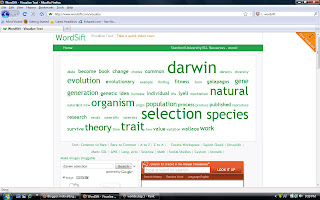WordSift was created to help teachers manage the demands of vocabulary and academic language in their text materials. This tool is helpful in supporting English Language by providing a fun and visually pleasing. Wordsift can be seen as a toy in a linguistic playground that is available to instantly capture and display the vocabulary structure of texts, and to help create an opportunity to talk and explore the richness and wonders of language. The tool works likely the same with Wordle. It is suitable to be used for 8-11 years old.
How to do it?
Step 1: Go to Wordsift website where you will find as below
Step 2: Select your text and paste it on the provided box
Step 3: Click the 'sift' button. You can sort the word from commonly use to rarely used as well as the opposite.
* If you want to know more about wordsift, you can visit Russell Stannard's website

step 3
Suggested activities:
Creative teachers will find an endless variety of uses for WordSift, but here are some ways:
Lesson preparation: A teacher can use WordSift to review assigned text to identify challenging words or concepts prior to a lesson, and identify images and videos to use in class. The videos (hidden but displayed by hitting “>Video”) can be especially useful in the preview function since many schools do not allow access to YouTube, but a teacher can download useful videos (such as a science lab demonstration) onto his or her laptop computer from home.
Previewing text: In whole class or individually, students can preview text. Reading comprehension research suggests that previewing text is a useful strategy for improving comprehension. Using WordSift to identify the key vocabulary, and playing with the images and to use the example source sentence feature to “skim” the text can help students who might otherwise struggle with the complexity of the text.
Group activities: Teachers have found simple activities using small portions of WordSift useful. For example, one teacher has developed a simple routine in which she gives students the TagCloud, and has them working in small groups to write or draw a page using the words in the cloud. Another possibility would be to take the Visual Thesaurus® display of a word web and have students identify and discuss related words.
Literacy support: Individual students can use WordSift as they read text, or as they write a response or summary. Adult users of WordSift have reported using WordSift for their own purposes to skim text and also to review their own writing drafts. The creator of WordSift, Kenji Hakuta, uses it to preview and scout around documents that promise to be boring, such as long education policy documents, clicking on key words.
I like it because:1. It is a fun way to learn language other than the traditional way which is quite boring
2. It can expand student's vocabulary with the help of thesaurus
3. It is marvelous for teacher to help students in finding key words in text
I don't like it because:
1. It is not good for a colour blind student. It may demotivate them to learn the language
2. Nothing more rather than highlighting few words from a text. Teacher needs to explore more on the tool to expand the activity.
Reference site:
Worsift on Youtube!
http://www.wordsift.com/site/about


1 comment:
interesting topic!enjoyed the lesson..!
Post a Comment